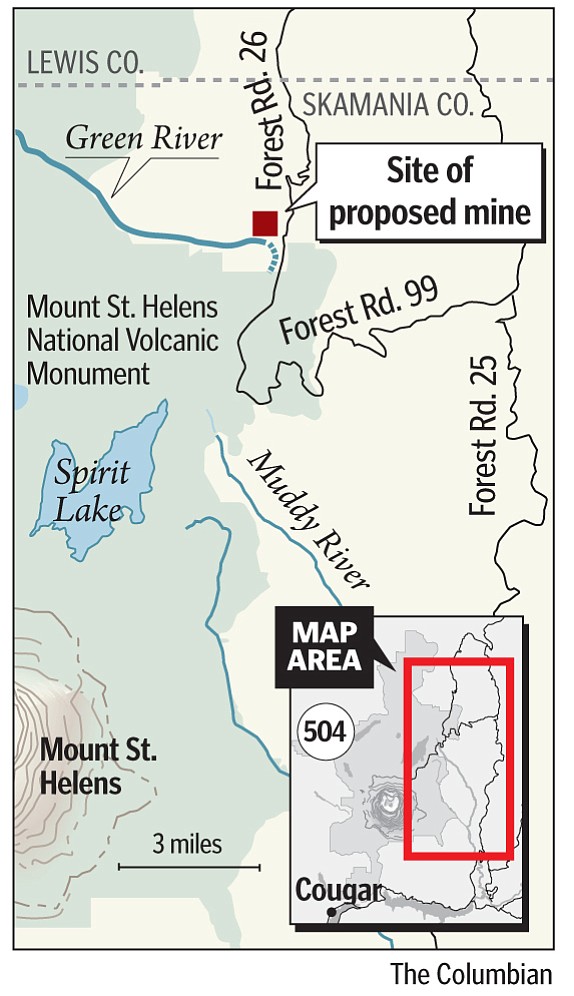Scientist seek sleepy volcano’s wake-up call
American Rivers, a national environmental group, has named the Green River at the north edge of the Mount St. Helens National Volcanic Monument one of the 10 most endangered rivers in the United States due to exploratory drilling by a Canadian company near the river’s headwaters.
“Mining, volcanoes and drinking water supplies don’t mix,” Darcy Nonemacher of the river protection group said in a statement released Tuesday. “There’s so much at stake in the Green River Valley. Not only does this river basin provide clean drinking water for local communities, it provides incredible opportunities for recreation, scientific research, and habitat for wildlife like salmon and elk.”
The river is a drinking water source for the cities of Longview, Kelso and Castle Rock.
Mining also would have an impact on popular recreation sites and patches of ancient forest that survived the 1980 eruption, the organization said.
“Contrary to claims by a mining company that the drilling is in a ‘devastated area,’ Mount St. Helens and the Green River valley is a beautiful region that is popular for recreation,” said Craig Lynch of Clark Skamania Flyfishers. “No private company has a right to degrade this natural and cultural treasure to make a buck.”
American Rivers is the second national group to single out the mine as a potential environmental risk. In April, the Pew Charitable Trusts identified Mount St. Helens along with the Grand Canyon and Yosemite national parks as areas at risk from provisions of the 1872 Mining Law. Pew said the proposed copper mine 10 miles north of the monument puts prospecting ahead of other activities on the monument and surrounding lands.
The law, a legacy of 19th-century western expansion, gives mining companies free and open access to nearly 350 million acres of public lands. It allows mining companies, including those that are foreign-owned, to patent proven claims, converting subsurface rights to private ownership, and to take about $1 billion annually in high-value minerals from public lands without paying a royalty.
Nearly 60 claims have been staked north of Mount St. Helens, most of them in 2004. Some are near the Green River and in national forest roadless areas; others are near holdings mining companies acquired from the federal government under the 1872 law.
Plans for a massive copper mine in the area were put on hold after a public outcry in 2008. But last year, Canadian company Ascot Resources Ltd. began exploratory drilling at the site. It has applied to drill 30 additional holes this summer.
The area, which contains copper, gold and molybdenum deposits, has long been a center of mining activity. When the boundaries of Mount St. Helens Monument were created, Congress purposely excluded the area for that reason, according to Ron Freeman, public services staff officer for the Gifford Pinchot National Forest.
Rick Kasum, operations manager for the Vancouver, B.C.-based mining company, expressed disbelief when contacted by The Columbian in April that anyone would object to mining in the area, which was squarely in the blast zone of the 1980 eruption.
“How can that be?” he said. “You’re in a devastated area already. Mount St. Helens is like a bomb went off. It’s all been clear-cut.”
American Rivers and its partners are calling on the Forest Service to give local communities a voice in the decision on whether to approve new drilling at the site. They’re also asking the agency to explore acquiring the company’s mineral rights and hoping they can interest U.S. Rep. Jaime Herrera Beutler in introducing a bill to protect the upper 10 miles of the Green River under the Wild and Scenic Rivers Act.
Lisa Moscinski of the Gifford Pinchot Task Force said the group discussed that option with former U.S. Rep. Brian Baird, but no legislation was ever introduced.
If mineral deposits valuable enough to be profitable are proved, it could still be at least a decade before the company satisfies environmental requirements and begins mining, Freeman said.
Kasum noted that the company already holds a patented claim to the main copper deposit.
“We could go and drill, but we want to work with the government on it,” he said in April. “We’ve been 100 percent environmentally sound. We want to do everything right.”
Kathie Durbin: 360-735-4523 or kathie.durbin@columbian.com.



